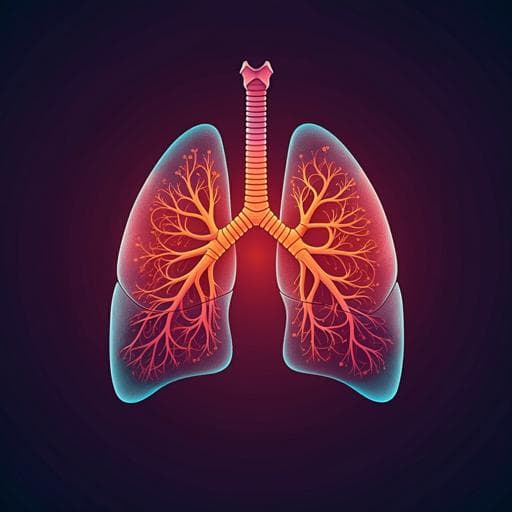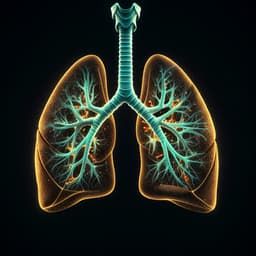
Medicine and Health
Association between pretreatment emotional distress and immune checkpoint inhibitor response in non-small-cell lung cancer
Y. Zeng, C. Hu, et al.
This prospective observational study by Yue Zeng and colleagues explores how pretreatment emotional distress affects the immune checkpoint inhibitor response in advanced non-small-cell lung cancer patients. Findings reveal that emotional distress is linked to significantly poorer clinical outcomes, emphasizing the critical need for addressing mental health in cancer care.
~3 min • Beginner • English
Introduction
Immune checkpoint inhibitors have transformed management of advanced non-small-cell lung cancer, yet only a minority of patients derive durable benefit and current molecular biomarkers (for example, PD-L1 and tumor mutational burden) are imperfect and can be challenging to implement. Host-related factors, including psychological status, may influence cancer outcomes. Emotional distress, typically reflected by symptoms of depression and/or anxiety and measured with validated instruments (PHQ-9 and GAD-7), is highly prevalent in lung cancer and far more common than in the general population. Preclinical work shows that sustained distress activates the HPA axis and sympathetic nervous system, elevating stress hormones and promoting immunosuppressive effects that can impair antitumor immunity and foster tumor progression. Limited clinical data have assessed whether pretreatment ED affects ICI efficacy. The STRESS-LUNG prospective study was initiated to test the hypothesis that pretreatment ED is associated with inferior clinical outcomes to first-line ICIs in advanced NSCLC; this Article reports cohort 1 (STRESS-LUNG-1).
Literature Review
Background evidence highlights high ED prevalence in lung cancer (about 33–77%) and its association with worse prognosis and mortality in cancer. Mechanistic studies implicate chronic stress-induced activation of the HPA axis and adrenergic signaling, leading to glucocorticoid and catecholamine effects that induce T-cell apoptosis, inhibit antigen presentation, reduce CD8+ T-cell and NK-cell function, and increase immunosuppressive cells (Tregs, MDSCs). Preclinical models indicate stress can diminish responses to PD-1/PD-L1 blockade. Prior clinical observations are sparse; a post hoc analysis in melanoma neoadjuvant immunotherapy suggested baseline ED correlated with lower major pathologic response and reduced relapse-free survival. Overall, these findings motivated a prospective clinical evaluation of ED as a predictor of ICI efficacy in NSCLC.
Methodology
Design: Prospective, single-center observational cohort (STRESS-LUNG-1; ClinicalTrials.gov NCT05477979) evaluating association between pretreatment ED and first-line ICI efficacy in advanced NSCLC. Primary endpoint: investigator-assessed progression-free survival (PFS). Secondary endpoints: objective response rate (ORR), overall survival (OS), and quality of life (QoL). Exploratory outcomes: longitudinal ED dynamics and associations of peripheral blood distress biomarkers (cortisol, ACTH) with outcomes.
Participants: Inpatients with unresectable locally advanced/metastatic/recurrent stage IIIB–IV NSCLC, age ≥18, ECOG PS 0–1, treatment-naive, at least one measurable lesion per RECIST v1.1, planned first-line PD-1/PD-L1 inhibitor monotherapy or in combination with chemotherapy. Key exclusions: EGFR ex19del/L858R, ALK or ROS1 fusions; other malignancies within 3 years; acute/chronic psychiatric disorders; current antidepressant/anti-anxiety therapy; prior clinical trial participation; symptomatic brain metastases; inability to complete psychological scales. Ethics approval obtained; written informed consent required.
Treatments: Approved first-line PD-1/PD-L1 agents (pembrolizumab, atezolizumab, camrelizumab, sintilimab, tislelizumab, toripalimab, sugemalimab) as monotherapy (for PD-L1 ≥1% or ≥50% per label) or in combination with platinum doublet chemotherapy (pemetrexed+platinum for nonsquamous; platinum with paclitaxel/nab-paclitaxel/gemcitabine for squamous) for 4–6 cycles, followed by maintenance (ICI ± pemetrexed for nonsquamous; ICI alone for squamous) up to 2 years or until progression, death, or unacceptable toxicity.
Assessments: Baseline demographics/clinics, imaging, and labs collected within the month prior to ICI start; tumor assessments every 2 cycles per RECIST v1.1; survival visits every 3 months. ED measured at baseline and again after ≥2 cycles (Time 2) using PHQ-9 and GAD-7. ED definition: PHQ-9 ≥5 and/or GAD-7 ≥5; severity: mild (5–9) and moderate-to-severe (≥10) on either scale. Dynamic ED categories from baseline to Time 2: never (no→no), onset (no→yes), remission (yes→no), persistence (yes→yes). QoL assessed with EORTC QLQ-C30. Peripheral stress hormones: fasting morning serum cortisol and ACTH at baseline under standardized conditions, quantified on Siemens immunoassay platforms.
Statistics: Descriptive statistics for baseline characteristics; group comparisons via χ2 or Fisher’s exact test for proportions, t-tests or nonparametric tests as appropriate for continuous variables. PFS and OS estimated by Kaplan–Meier and compared with log-rank tests; associations quantified by Cox proportional hazards models with multivariable adjustment (pre-specified covariates). Propensity score matching (1:1 nearest neighbor; caliper 0.2) and inverse probability of treatment weighting (IPTW) used to balance covariates (final covariates: sex, pathology) between ED and no-ED groups. Sensitivity analyses: ED severity vs outcomes; alternative ED cutoff (PHQ-9+GAD-7 sum ≥10). Optimal cutoffs explored via survminer in R. Data cutoff: 30 November 2023.
Key Findings
- Population: 348 screened; 232 enrolled on first-line ICI; 227 eligible for analysis (ED n=111, no ED n=116). Baseline ED prevalence 48.9%; 55.9% mild, 44.1% moderate-to-severe. ED group had higher proportions of females (11.7% vs 3.4%; P=0.018) and nonsquamous histology (47.7% vs 29.3%; P=0.004); other characteristics balanced.
- Primary endpoint (PFS): Median follow-up 16.0 months. Overall median PFS 9.2 months. ED vs no ED: median PFS 7.9 (95% CI 6.2–9.7) vs 15.5 months (7.8–23.2); HR 1.73 (95% CI 1.23–2.43), P=0.002. Multivariable Cox: ED HR 1.63 (1.15–2.31), P=0.006; stage IV HR 1.72 (1.13–2.63), P=0.012; PD-L1 ≥50% favorable (HR 0.42, 0.24–0.72), P=0.002. Subgroup analyses largely consistent across age, PD-L1, NLR, smoking, histology, stage, therapy type, and metastasis status.
- Propensity analyses: PSM (n=180): median PFS 7.9 vs 18.0 months; HR 2.08 (1.42–3.04), P<0.001. IPTW: median PFS 7.9 vs 15.5 months; HR 1.71 (1.21–2.42), P=0.002.
- ED severity and PFS: Mild ED HR 1.78 (1.20–2.64), P=0.004; moderate-to-severe ED HR 1.67 (1.09–2.53), P=0.017, each vs no ED. Depression symptoms alone: HR 1.71 (1.22–2.40), P=0.002; anxiety alone: HR 1.41 (0.97–2.04), P=0.070. Alternative cutoff (PHQ-9+GAD-7 ≥10): HR 1.51 (1.07–2.13), P=0.020.
- Secondary endpoints: ORR overall 54.6%. ED vs no ED ORR 46.8% (95% CI 37.6–56.1) vs 62.1% (53.2–70.9); OR 0.54 (0.32–0.91), P=0.022. Depth of response median best change: −28.2% (ED) vs −39.2% (no ED), P=0.008. OS: 69 events; ED associated with higher death risk HR 1.82 (1.12–2.97), P=0.016; 1-year OS 70.4% vs 80.8%; 2-year OS 46.5% vs 64.9%. PSM OS HR 2.06 (1.22–3.48), P=0.007; IPTW OS HR 1.87 (1.15–3.06), P=0.012. By severity: moderate-to-severe ED HR 2.11 (1.20–3.73), P=0.010 vs no ED.
- QoL: ED associated with worse global health and all functional domains, and higher symptom burdens (fatigue, pain, dyspnea, insomnia, appetite loss, constipation, financial difficulties), all P≤0.027; no differences for nausea/vomiting or diarrhea.
- ED dynamics (n=187 with Time 2): 38.5% never ED, 15.0% onset, 13.9% remission, 32.6% persistence. Time 2 ED vs no ED: median PFS 7.8 vs 15.6 months; HR 1.91 (1.32–2.77), P<0.001; OS HR 2.09 (1.19–3.66), P=0.010. ORR by dynamics: never 65.3%, onset 57.1%, remission 69.2%, persistence 36.1%; remission vs persistence P=0.004. PFS by dynamics: never 17.9 months; onset 8.7; remission 12.7; persistence 6.5. Remission vs persistence HR 0.51 (0.27–0.94), P=0.030; onset vs never HR 1.38 (0.76–2.50), P=0.294. OS: onset vs never HR 2.42 (1.01–5.80), P=0.048; remission vs persistence HR 0.69 (0.30–1.61), P=0.394.
- Biomarkers: Baseline serum cortisol higher in ED vs no ED (443.4 vs 386.0 nmol/L), P=0.019; ACTH similar (31.0 vs 31.1 ng/L), P=0.700. High (≥median) cortisol associated with shorter PFS (7.8 vs 12.6 months; HR 1.55, 1.09–2.19; P=0.014) and higher death risk (HR 1.82, 1.10–3.02; P=0.021); ORR trend lower (51.4% vs 60.0%; P=0.211).
Discussion
This prospective cohort demonstrates that pretreatment emotional distress is associated with inferior outcomes to first-line ICI-based therapy in advanced NSCLC, including shorter PFS, lower ORR, and higher risk of death. The association persisted across clinically relevant subgroups and after balancing with PSM and IPTW, and it scaled with ED severity. Longitudinal analyses showed that persistent ED correlated with the poorest outcomes, whereas ED remission was associated with improved PFS and ORR, underscoring the potential clinical relevance of monitoring and addressing ED over time. Elevated baseline cortisol in ED and its association with worse survival support a neuroendocrine mechanism whereby stress hormones suppress antitumor immunity and diminish ICI benefit, consistent with preclinical findings. These results suggest integrating psychosocial assessment into baseline risk stratification and raise the possibility that interventions targeting ED or stress pathways (for example, psychological support, β-adrenergic or glucocorticoid receptor modulation) could enhance immunotherapy efficacy. The data also suggest that ED may complement molecular biomarkers such as PD-L1, motivating a ‘psycho-biomarker’ concept for predicting ICI outcomes.
Conclusion
Pretreatment emotional distress is common in advanced NSCLC and is associated with diminished clinical benefit from first-line ICI therapy, including shorter PFS, reduced ORR, and worse OS, with corroboration from sensitivity, propensity, and longitudinal analyses. Elevated cortisol provides biological plausibility linking ED to outcomes. These findings support routine screening and management of ED in immunotherapy candidates and suggest that combining psychosocial factors with molecular biomarkers could improve prediction of ICI response. Future research should validate these findings across diverse populations and cancer types, refine ED cutoff thresholds with gold-standard interviews, and test interventional strategies (for example, psychological therapies and β-blockers) to mitigate ED and potentially improve immunotherapy outcomes.
Limitations
Single-center observational design limits causal inference; residual confounding may persist despite multivariable adjustment, PSM, and IPTW. Overall survival data were immature at cutoff. The cohort was predominantly male and entirely Chinese, limiting generalizability to females and other ancestries. Multiple PD-1/PD-L1 agents and regimen variations were included, potentially introducing heterogeneity. ED was defined using patient-reported PHQ-9/GAD-7 thresholds (≥5), and alternative cutoffs may be relevant; structured clinical interviews were not performed. Potential unmeasured confounders may influence both ED and outcomes.
Related Publications
Explore these studies to deepen your understanding of the subject.







